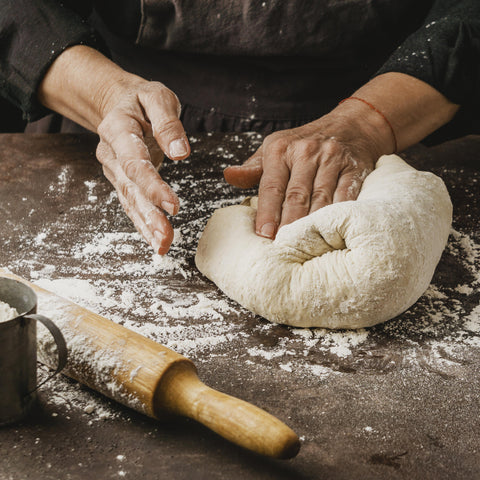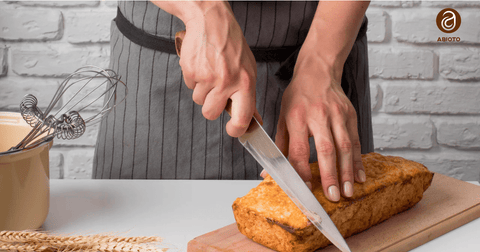Ever wonder how artisan bread bakers get such perfect round loaves every single time? Besides years of practice, they’re also using a proofing basket to help the loaves keep their shape and structure through their final rise. Proofing baskets or bread proofer aren’t just relegated to the realm of professional baking — they are readily available to home bakers and a cinch to use.
Choosing the right proofing bowl isn’t just about convenience—it directly affects the rise, texture, and final shape of your loaf. Whether you're a weekend baker or a daily sourdough enthusiast, the right bowl can elevate your entire baking game. In this article, we'll dive into why your proofing vessel matters, what to look for, and how ABIOTO’s tools—including the bread proofer and bowls—help you bake like a pro every time.
Understanding the Basics of Proofing Basket
Also called brotforms and bannetons, proofing baskets can be found in just about every shape and size: round, oval, or long. You can line them with linen for a smooth texture on your bread, or they can be left unlined, and the pattern of the basket will imprint on your dough. The gluten relaxes as the dough proofs, causing shaped loaves to spread out and flatten as they rise. A basket supports the dough as it proofs and prevents this from happening.
How To Use A Proofing Bowl for Bread?
To use one, first prepare the basket by coating it (either the bare basket or the linen liner) thoroughly with flour and shaking out the excess. Make your bread right through the shaping step. Instead of proofing it on the countertop, dust the surface of the shaped loaf with flour and invert it into the proofing basket so that the “top” of the dough is on the bottom of the basket and the underside is visible.
To bake, lay a piece of parchment on your baking peel or sprinkle the peel with cornmeal. Lightly dust the proofed dough with cornmeal or flour and invert it onto the peel. Slash the top and bake the loaves immediately.
If you’re working with a particularly delicate dough or one that didn’t rise as much, sometimes you’ll need to use one hand to support the underside of the dough so that it doesn’t fall too hard onto the peel and deflate.
Why A Proofing Bowl Is Important In Bread Baking?
Because they shape and support the dough during its last fermentation or proofing phase, proofing bowls are crucial for artisan bread. These bowls let air flow that develops the crust and give bread its lovely, distinctive texture.
A proofing bowl provides the bread-making process with the following:
-
Dimensions and Shape: The proofing basin preserves the structure of the dough, therefore providing form and volume.
-
Moisture Control: By wicking away moisture, the materials used in proofing bowls, such as wood pulp or rattan, leave the dough with the ideal crust.
-
Aesthetic Appeal: The spiral pattern or form of the bowl can leave an appealing impression on the dough, therefore adding a decorative element.
Choosing the Right Proofing Bowl for Bread Every Time
When choosing a proofing bowl at Abioto, you will find a wide range of materials and designs, each with its own advantages. Below are the best proofing bowls for your perfect bread.
-
Rattan or Banneton Bowls: Bannetons are the traditional choice of proofing bowls for breads, perfect for rustic breads and sourdough. They wick moisture from the surface of the dough, giving a crust but leaving the characteristic spiral on the bread.
-
Wooden Proofing Bowls: A less common choice, these will provide excellent temperature regulation for your dough and add old-world charm to your bread-making.
-
Plastic Proofing Bowls: Plastic bowls are light in weight and inexpensive, easy to clean and good for beginners. These usually have lids, helping to retain moisture.
-
Ceramic and Glass bowls: They can be used for observing dough that has been rising, and they also are convenient to use as serving bowls.
How to Prepare Your Bread Proofer For Use?
Avoiding stickiness and guaranteeing equal proofing depends on properly cleaning your proofing bowl. Here's how to get it ready for optimal effects:
-
Dust the Bowl
Before putting the dough, kindly sprinkle the proofing basin with flour. Rice flour decreases stickiness, so it works very well.
-
Coat Sticky Dough
To keep high-hydration doughs from sticking, gently dust or oil your hands and scatter extra flour in the bowl.
-
Pre-conditioning new baskets
Before initial usage, spritz a fresh rattan or wood pulp bowl with water and then flour it a few times.
Your dough will release easily from the bowl with correct preparation, which will simplify transfer to the baking surface without deflation.
Key Features To Look For in a Proofing Bowl for Bread
-
Shape and Size
Round or oval bowls are standard, depending on the type of loaf you're baking. A well-sized bowl should:
-
Accommodate dough expansion (about double in size)
-
Match your loaf shape
-
Fit inside a bread proofer or oven if needed
-
Material Matters
Choose breathable materials like wicker or lined rattan for crusty artisan bread. For wetter doughs or enriched bread (like brioche), non-porous bowls like glass or plastic may work better.
-
Easy Release and Cleaning
A good proofing bowl from Abioto will definitely allow dough to release easily onto your baking surface without tearing. Linen-lined bowls and those with a natural flour layer help avoid sticking while creating that rustic crust we all love.
Quick Tips for Getting the Perfect Rise and Crust
Using your proofing bowl, think about these useful ideas to get bread of bakery quality:
-
Use Rice Flour: Dust your proofing bowl with rice flour. Its reduced water absorption than wheat flour reduces stickiness.
-
Chill, Dry Environment: Your dough will have a consistent texture if you proof in a colder, less humid atmosphere.
-
Experiment with Hydration Levels: Though they are more difficult to manage, high-hydration doughs may have the most open crumb structure. Strike a balance suitable for your level of ability.
Let’s Take Your Bread Game To the Next Level
Tired of guessing when your dough is ready? Want a more consistent crumb, a loftier rise, and picture-perfect loaves every time?
With ABIOTO’s premium proofing bowls for bread and temperature-controlled bread proofer, you can:
-
Control every element of the rise
-
Prevent over-proofing or under-proofing
-
Bake with professional-level consistency
Proof With Confidence, Bake With Pride
Choosing the right proofing bowl for bread may seem like a small detail, but it’s one that dramatically impacts your baking success. Combined with a high-quality bread proofer, you can achieve artisan-quality results without stress or guesswork.
Explore our website now and let us get you from dough to delicious.




Comments (0)
There are no comments for this article. Be the first one to leave a message!